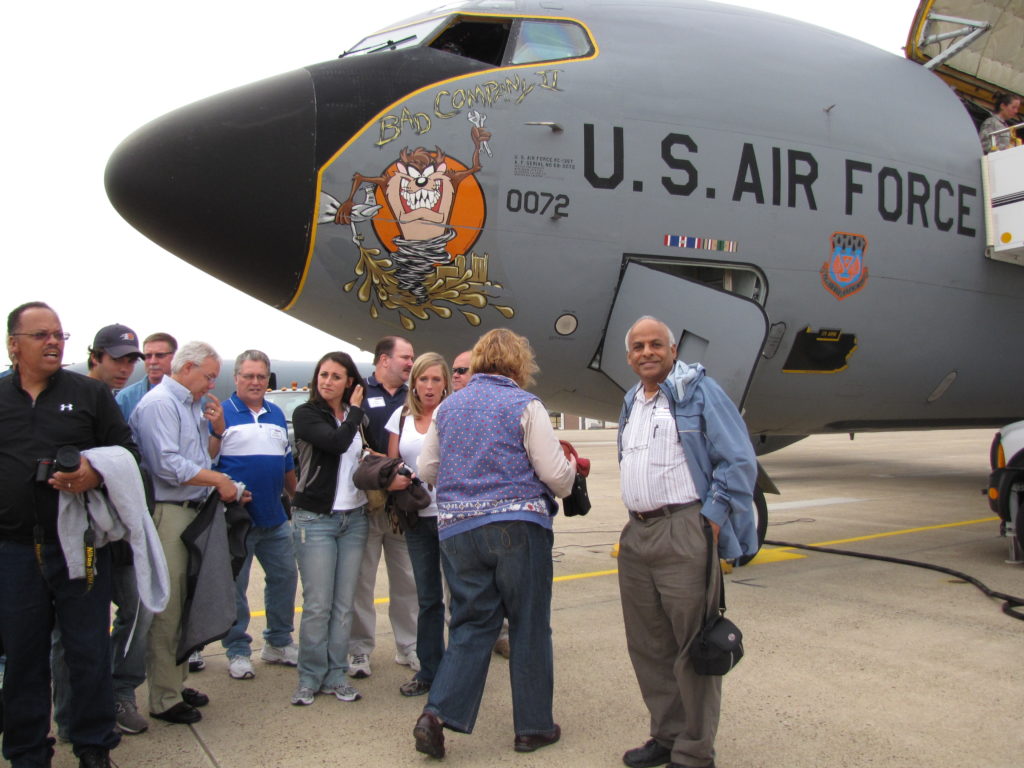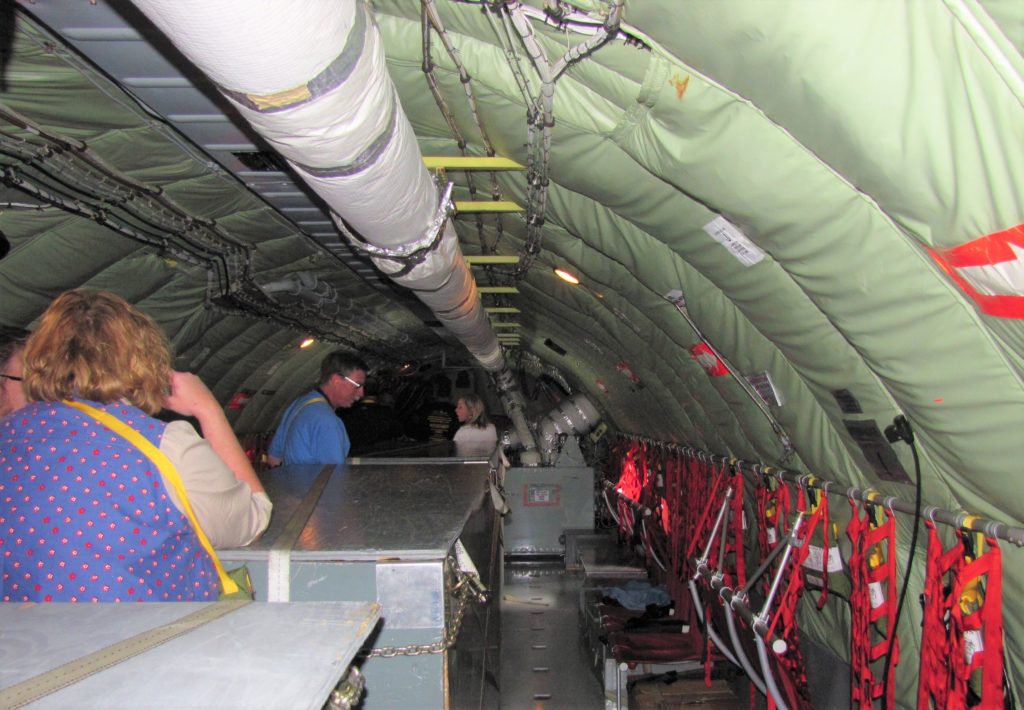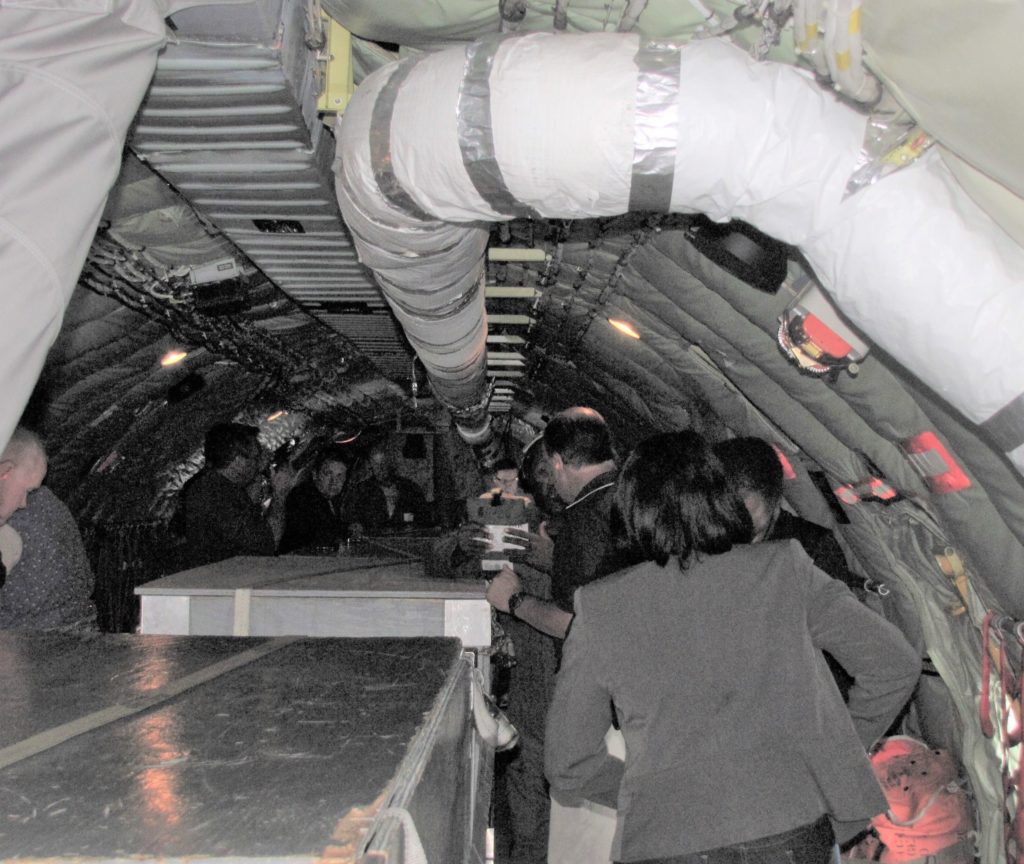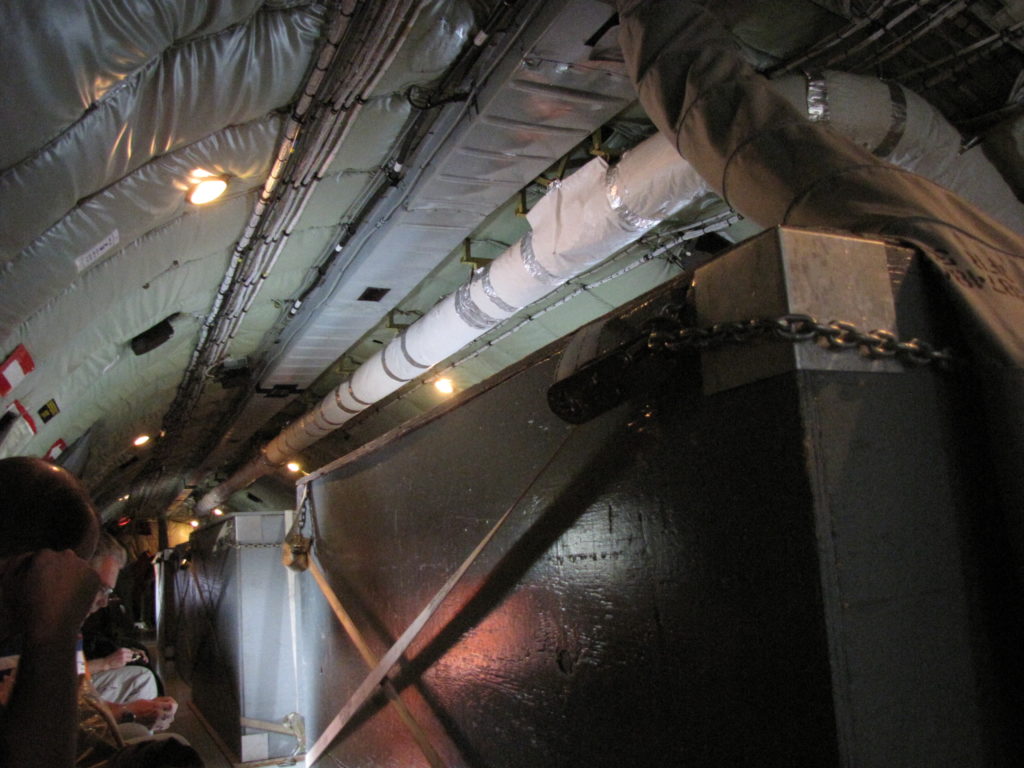Kollengode S Venkataraman (published in October 2009)
Recently in the wake of the FBI Citizens Academy graduation I had a unique opportunity to witness and participate in a air refueling operation by the Penna Air National Guard operation.
The Pennsylvania Air National Guard’s 171 Air Refueling Wing operate from their base close to the Pittsburgh airport using the airport’s infrastructure — runways and air traffic control — to reduce their costs for their operating their flights. I was one of the over dozen participants in this exercise.
Air refueling is a 100% military-related operation but the Guardsmen, who are under the command of the governor in most states, also respond to natural disasters for supply and rescue mission, as they did during Katrina.
On the stated date (July 22, a Wednesday), we assembled at the Air National Guard facility adjacent to the airport. I was under the impression that they would show us a video, or make us sit in a simulator — maybe take us for a short ride, over Lake Erie and bring us back.
But was I in for a huge surprise!
As we sat through the briefing by Brig. Gen. Rou Uptegraf, Commander of the Pennsylvania 171 Air Refueling Wing of the Pennsylvania Air National Guard, it became crystal clear that this was THE Real Deal!
The flight crew (two part-time volunteer pilots Eric Yockey and Keith Stephen and two full-time “Boom†operators John Cima and his colleague) informed us that we would fly due east all the way to the Atlantic shoreline in the NY/NY area and fly well into the ocean. We would be air-borne for nearly 4 hours! There, our “mother†plane would dock with another plane requiring refueling during flight.
We had been asked to come prepared for cold temperatures inside the plane and were also cautioned that the plane’s toilet facilities are minimal.
The utilitarian 50-year old plane was C-135, the military version of the old Boeing 707. We drove past several of these planes, something that you can see if you land on the run way closest to their parking yard. We entered the grey painted plane through the very large door on the side. Even though thee planes are very old, we are told, their dedicated crew take great pride in keeping the plane fully operational ALL the time.
The barebones interior was with wires and cables and HVAC ducts exposed and running the entire length of the plane. The highly visible insulation/noise muffling layer was kept in place with the liberal usage of what appeared to be duct tape. The plane had only 4 windows – two on either side – along the entire length of the fuselage. The cockpit was open to those who were riding in the plane.
The seats arranged along the length of the fuselage were barely functional, made with woven 2†or 3†wide bright red tapes like what we see in garden chairs. In the middle of the fuselage along the length of the plane were five sets of multipurpose cargo boxes for transporting anything that would fit into the box.
As the plane taxied to the runway, even before we were airborne, it was clear this would be a very, very noisy ride.
Once we were cruising at 26,000 feet we walked around the cabin. All of us took turn and entered the cockpit during the flight and sat right behind the two pilots. To have the pilot’s view (nearly 270 degree views) of what was outside the plane was a treat of a lifetime for all of us. The veteran pilots were joking around with us even as they were fully focused on their job, making small talks with me on radio/intercom.
Exciting as the cockpit view of the outside was, the real action was all at the tail end of the aircraft! For this is where the maneuvering for the refueling takes place. Conceptually, a hose from the “mother plane†has to dock into the fuel receptacle on the fuel-receiving plane. The only constraint is that this has to be done at 20,000 to 30,000 ft in the air while the two planes are flying at nearly 500 mph. And everything has to be done by remote control.
This is where the “boom†operators come in. These highly skilled technicians’ agility, skills and concentration at their task and their professionalism are very inspiring. They train, we are told, hundreds of hours on simulators, perfecting their technique before getting trained under a veteran boom operator in actual flight.
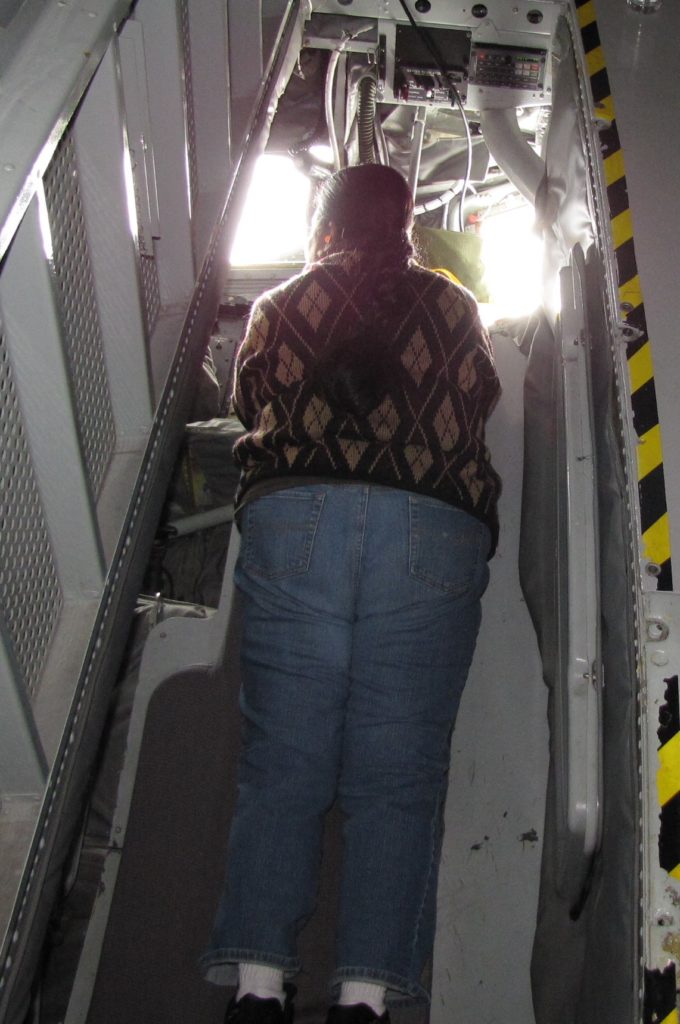
The whole operation takes highly coordinated communication among the pilots in both the planes and the boom operators as they maneuver the two planes close enough – but not too close — to dock the fuel hose from the mother plane to the receptacle on the top of the front end of the receiving plane, just above its cockpit.
The boom operator working with very limited space operates several joysticks and control knobs to move the “boom,†— which has the hose installed in it. He lies flat on his stomach on a padded mat like a Yoga mat and operates the joysticks and other knobs while looking through the three windows, the largest of which measured maybe 24†x 12â€. By working on the joystick, the boom operator moves the hose independent of the mother plane, and with great skill, docks the discharging end of the hose on the receptacle on the top of the receiving g plane. When the hose coupling comes very close to the receptacle of the receiving plane, a powerful electromagnet attracts the hose plumbing fixture and locks it into position on the receptacle in the receiving plane.
I was looking through the window lying on my stomach on the mat adjacent to the boom operator as we were flying at 26,000 ft at ~ 500 mph (ground speed). At a far-away distance, I saw a plane approaching us. The boom operator told us, that is the plane we were about to re-fuel in flight.
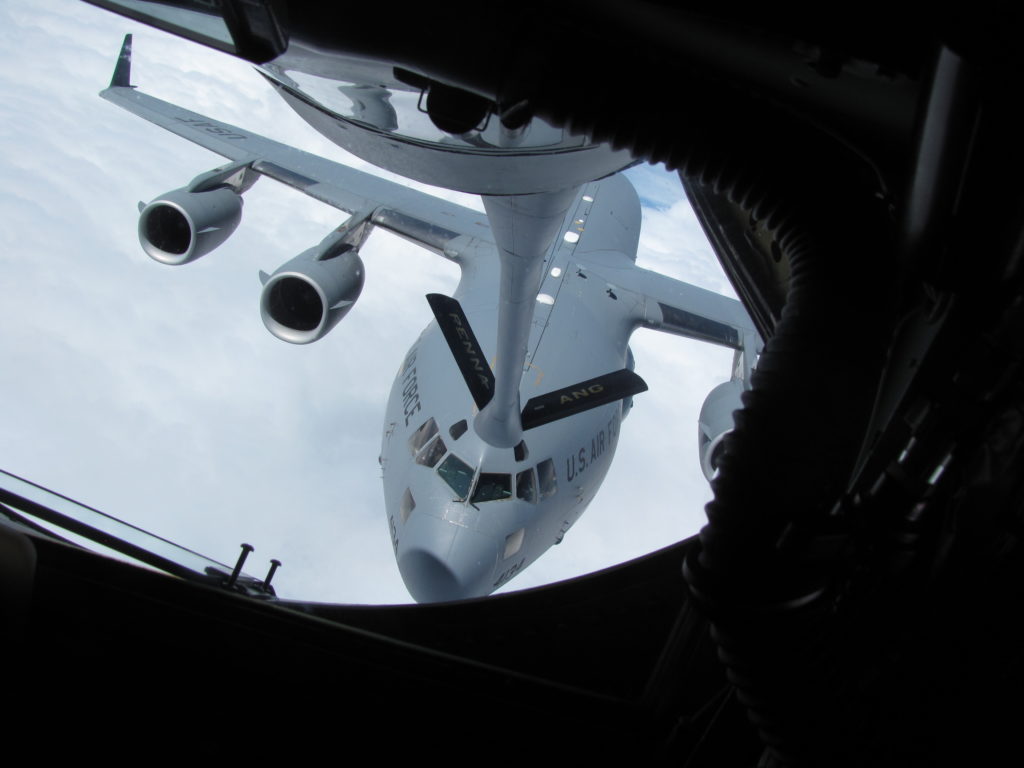
As the plane got closer to us, I could see the military jet plane’s four-engines… … then I saw the inscription US AIR FORCE painted on the side of the fuselage. And then I could see the number on the plane 3084.
As the plane needing the fuel got closer still, I could even see the pilots in its cockpit. When the plane got closer at ~ 200 feet, I could see the fuel hose receptacle, even the rivets on the fuselage and the scratch marks when the hose made contacts with the plane near the receptacle. It was an eerie experience seeing a plane in flight this close.
All the while, the Boom Operator was constantly in radio/intercom communication with the pilots in both the planes even as he was maneuvering his joysticks to bring the hose’s end of his plane to the receptacle on the receiving plane. When they come close enough, powerful electro magnets on the planes quickly brought the two ends into contact and instantaneously locked the hose into its receptacle making it ready for refueling. The Boom operator then worked his buttons to open and close the necessary valves and the jet fuel from his mother ship’s underbelly was transferred to the other plane. The unloading took may be 20 minutes transferring several thousand gallons of the fuel.
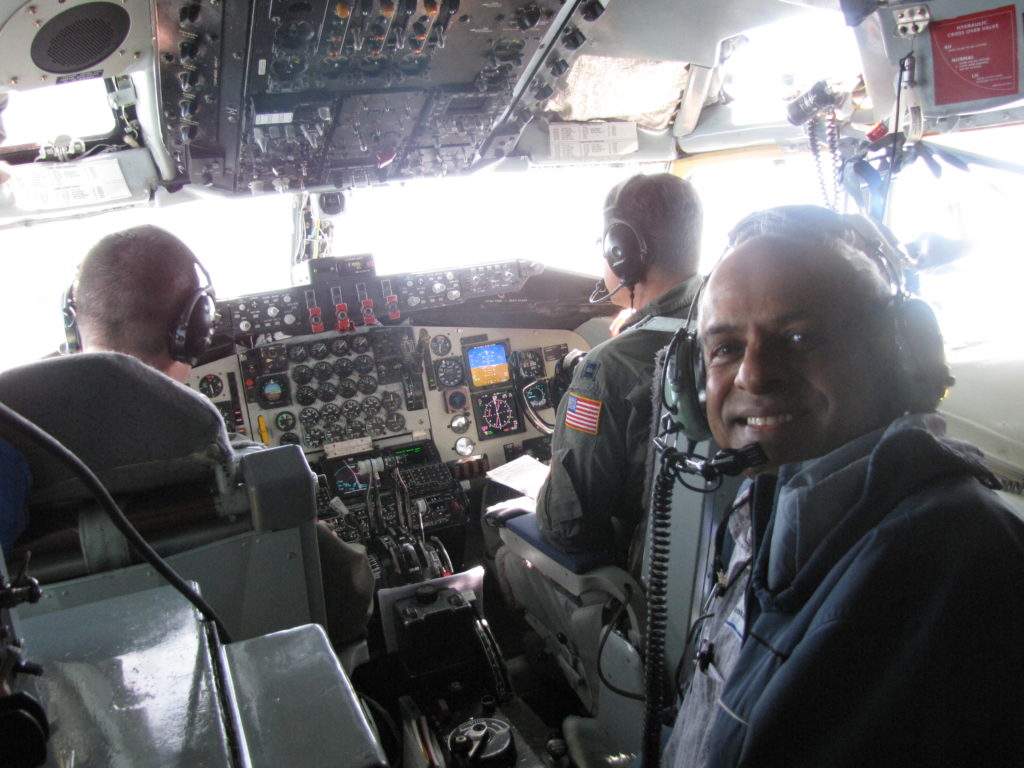
Finally, his job completed, the boom operator instructed the pilots in both ships, he is going to decouple the hose. He detached their umbilical chord, and I could see the other plane slowly receding from my plane both in distance and elevation. After some time, the plane outside veered away from ours.
Having completed our training mission, the pilot returned his plane and brought us back to Pittsburgh.
It was an unforgettable experience. I was so impressed with all the pilots, boom operators and other staff working with their absolute dedication and professionalism and pride in their skills and abilities in keeping the country safe in times of war, terrorist threats and natural disasters.
We owe them a huge debt of gratitude though we may never need their services. — END

